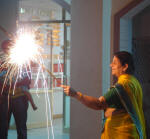Diwali, Jaipur, Rajasthan, India
Diwali is celebrated over a five-day period from the 13th day of the dark half of the Hindu month Ashwina to the 2nd day of the light half of Karttika (late Oct / early Nov). Derived from the Sanskrit term dipavali, or row of lights, the festival is observed with particular enthusiasm by members of the merchant communities and honors Lakshmi, the goddess of wealth (in Bengal the goddess Kali is worshipped. More on that here). During the festival, small earthenware lamps filled with oil are lighted and placed in rows along the parapets of temples and houses and set adrift on rivers and streams. This commemorates the return of Rama (an incarnation of the Hindu god Vishnu) to Ayodhya and his coronation as king after 14 years in exile. The fourth day-the main Diwali festival day-also marks the beginning of the new year according to the Vikrama calendar. Merchants perform religious ceremonies and open new account books.
Diwali is a time for visiting, exchanging gifts, decorating houses, bursting firecrackers, feasting, and wearing new clothes. Gambling is encouraged in this season, [ostensibly] to invite good luck for the year ahead and in remembrance of Lord Shiva and Parvati's games of dice on Mount Kailasa. Diwali is also an important festival among members of the Jain community, many of whom belong to the merchant class. For the Jains, the day commemorates the passing into Nirvana of Mahavira, the most recent of the Jain Tirthankaras, or saints. The lighting of the lamps is explained as a material substitute for the light of holy knowledge that was extinguished with Mahavira's passing. ♣
|
Diwali 2006 |
|||
|
Fireworks  |
C-Scheme neighborhood  |
SMS Stadium  |
Rajmandir cinema hall  |
Johri Bazaar (LMB)  |
Nehru Bazaar  |
||
MI Road  |
Paanch Batti square  |
||
"Gold Palace" store  |
Mini Taj  |
Pyramids of Egypt  |
Leaning Tower of Pisa  |
Statue of Liberty  |
Anaar  |
||
Puja shrine at home  |
Diwali puja  |
||
Patakhas (inside)  |
Spinning top  |
||
Diwali 2004 |
|||
Paanch Batti square  |
Johri Bazaar  |
Jewelry shop  |
Laxmi Misthan Bhandaar  |
Birla temple  |
Mall 21  |
Chandpol market  |
Street  |
Nehru Bazaar  |
C-Scheme neighborhood  |
Rajmandir cinema hall  |
Sangaaneri gate  |
Earthenware oil lamps  |
Festival shrine at home  |
Beaming Ms. in new clothes  |
Family & friends  |
Firecracker shop  |
Firecrackers ...  |
or patakhas  |
Marketing laris  |
Firecrackers ... 1  |
2  |
3  |
4  |
Fireworks ... 1  |
2  |
3  |
4  |
Flare  |
Mithai shop  |
Menu  |
Yummy?!  |
Designed in collaboration with Vitalect, Inc. All rights reserved. |








